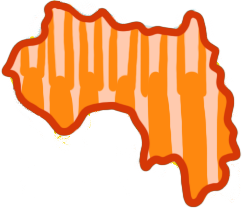Text
Despite efforts in promoting Maninka language literacy and education since Guinea’s independence, few speakers of the language today use the official Latin-based system.
Today, it’s clear that there is more written text—in newspapers, books and webpages, etc—produced in N’ko (ߒߞߏ) than in the official Latin-based system.
A non-Latin, non-Arabic based script invented in 1949 by a man named Sulemaana Kantè, N’ko was not created as an alphabet exclusively for Maninka, but as a standard system to unite all the Manding varieties: Bambara, Jula, Maninka and Mandinka.
During his life, Kantè authored a vast quantity of books that included a series on West African history, a monolingual (Manding to Manding) dictionary and a translation of the Quran.
His enduring legacy, however, is the growing number of people that read and write in his script today. You can see N’ko written across storefronts in cities like Conakry, Bamako, Bobo-Dioulasso, Kankan and Abidjan. It’s used extensively online; mostly in popular groups chats on messaging apps like WhatsApp and Telegram.
For all these reasons and many others, it is worthwhile for any serious student of Maninka to get acquainted with the N’ko script.
(NOTE: Full disclosure, I wrote my doctoral dissertation about the N’ko movement. If you are curious to learn more about N’ko, I have also published a few articles that might be more digestible: one comparing the emergence and divergent philosophy behind the N’ko and Latin orthographies; one investigating language standardization within N’ko circles, and one investigating the role of Islam and the tradition of Ajami in Sulemaana Kantè’s life and thought.)
The Alphabet
This section is a basic introduction to the major letters of N’ko.
Here’s what we’ll cover:
- Vowels (which are known as
siiralannuin N’ko circles) - Consonants (
siiratalu) - The syllabic nasal letter (
tɛdɔ) - Contextual variants of two letters (
wolosoletters)
I’ve included a few footnotes to explain some of the nuances that distinguish N’ko from Latin-based orthography.
But the best way to learn is actually practice writing! Follow this tutorial that I made to get yourself started!
And one final note to remember as you learn the individual letters: N’ko is written right to left and the letters are connected along the bottom.
For instance (assuming that your device displays the letters correctly and not just as some blank squares; if that happens, you need to install the appropriate font):
ߒߞߏ
{n’ko} [TRANSLITERATION]
Vowels
First up, the vowels!
| N’ko | Transliteration |
|---|---|
| ߊ | a |
| ߋ | e |
| ߍ | ɛ |
| ߌ | i |
| ߏ | o |
| ߐ | ɔ |
| ߎ | u |
Consonants
Next up, the consonants!
| Letter | Transliteration |
|---|---|
| ߓ | b |
| ߗ | c |
| ߘ | d |
| ߝ | f |
| ߜ | gb1 |
| ߤ | h |
| ߖ | j |
| ߞ | k |
| ߟ | l |
| ߡ | m |
| ߣ | n |
| ߢ | ɲ |
| ߔ | p |
| ߙ | r |
| ߚ | rr2 |
| ߛ | s |
| ߕ | t |
| ߥ | w |
| ߦ | y |
“Tɛdɔ”: The Syllabic Nasal
Finally, we have a special letter that is neither a vowel nor a consonant: the syllabic nasal, which is called tɛdɔ (lit. tɛ-dɔ ‘between-in’, as in, “in between [a vowel and consonant]”) in N’ko.
| Letter | Transliteration |
|---|---|
| ߒ | n3 |
“Woloso” Variant Letters
In N’ko orthography, two letters ߟ ná-woloso and ɲá-woloso respectively, that are used to mark allophonic variation that occurs when the the sounds /l/ and /y/ are preceded by a nasal sound (e.g., a nasalized vowel [see below], tɛdɔ, or a nasal consonant like n, etc) and end up sounding like [n] and [ɲ].
Here’s a table to show you an example of the way that a word with ߟ or ߦ can sometimes be written with ߠ or ߧ respectively:
| Base Word | Base Word Transliteration | Woloso Example | Woloso Example Transliteration | Woloso Example Translation |
|---|---|---|---|---|
| ߟߊ߫ | la | ߓߏ߲ ߠߊ߫ | {bon na} | ‘at the house’ |
| ߦߋ߫ | ye | ߒ ߧߋ߫ | {n ɲe} | ‘for me’ |
What’s important to retain is that you don’t write such variation with ߣ woloso letters since the underlying letter is ߟ
-
The letter
ߜrepresentsgb,gworg—that is, the range of possible local pronunciations for a single word likegɛlɛn/gwɛlɛn/gbɛlɛn‘difficult; hard’. By convention, it is easiest to simply always transliterate it asgbin the Latin script. This is similar to the way that Bambara spelling states that one should only writeg(e.g.,gɛlɛn) even though local pronunciations often are agwsound.↩︎ -
The letter
ߚis known asra-filanin, which means ‘little twin R’. It is treated as a separate letter in N’ko and is used in words where anrseems to repeat itself in a trill-like fashion; in Latin script is normally represented by multipler‘s separated by vowels (e.g.,fururu’for a long time’).↩︎ -
The letter
ߒrepresents the sound syllabic nasal phoneme (e.g., the sound that forms the word for the first person singular pronoun, “I” in Bambara). In Latin-based orthography, this is simply represented by the lettern—the same letter used for the “regular” consonantnthat is found in words such asnɔnɔ‘milk’.↩︎
Diacritics
In this section, I will briefly cover the basics of some of the important diacritics that appear above or below letters to mark Manding tone, length or nasalization.
Nasalization
In N’ko, nasalization is marked by a single dot, known as kannadiyalan (lit. ‘thing that makes speech pleasing’) that appears below the vowel in question:
ߓߏ߲
/bõ/ [PHONETIC]‘house’
In contrast, in Latin script orthography, nasalization is marked by placing an n after a vowel.
bon
/bõ/ [PHONETIC]‘house’
Length and Tone
In many Maninka (and many Manding varieties), vowel length can distinguish words. In Latin script orthography, this is marked by simply doubling the vowel in question.
si
‘pass the night’VS
sii
‘sit’
In N’ko script orthography, this is marked by the use of a series of diacritics (known as kanmasere [or kanmaserelu in the Maninka plural]) that appear above vowels.
(NOTE: “Diacritics” are often referred to as ‘accents’ or ‘accent marks’ in Western languages such as French or Spanish.)
For example:
ߛߌ߬
{si}‘pass the night’
VS
ߛߌ߰
{sii}‘sit’
What complicates the matter is that kanmasere simultaneously mark tone, which is also contrastive in Manding. This means that we could actually transliterate the previous example as follows. Make sure to note the diacritic marker above the i for both words’ transliteration:
ߛߌ߬
{sì}‘pass the night’
VS
ߛߌ߰
{sìi}‘sit’
Tone, however, is not generally marked when Maninka is written in Latin script orthography though. That is why it has not been marked in any previous example or chapter.
At this stage, it’s not worth introducing Maninka’s tonal system in full.
Instead, what you should retain is that kanmasere diacritics in N’ko orthography represent both length and tone and that both of these features can distinguish the meaning of words and sentences in Maninka. As such, do not be surprised to encounter them in N’ko texts even if you don’t yet fully master them.
The Gbarali Convention
In N’ko, there is a spelling convention known as the gbarali rule. It stipulates that when two identical vowels carrying the same tone are preceded and separated by two distinct consonsants, then the first of two vowels is dropped.
For example, take the following word in Latin-based spelling—note that I have included tone on all syllables in this case since it is part of the rule:
fɛ́lɛ́
‘look’
Since the word has two identical vowels with the same tone (e.g., ɛ́), and since they are separated by two distinct consonants (e.g., f and l), the gbarali rule applies in N’ko.
This means that the first ɛ́ is dropped.
So instead of writing:
ߝߍߟߍ
We write the following:
ߝߟߍ߫
{flɛ́}‘look’
(NOTE: If you are wondering about the diacritic above the final vowel ߍ in the example, do not worry about it. It is related to the tonal system, which you will learn about later.)
This rule may appear rather complicated or even unnecessary at this point. It will get easier to recognize or apply with time. What is important for now is that you able to recognize it, since you will encounter it in any N’ko texts that you run into!
How to type in N'ko
You don't need it for the exercises below, but once you can read and write in the N'ko script, you might also want to be able to type it on your computer, phone or tablet. To do that, you need to install the correct keyboard.
Vocab
Coming soon n'Ala sɔnna!
- ߊ
- a
- o
- e
- ߍ
- ɛ
- ߌ
- i
- ߏ
- o
- ߐ
- ɔ
- ߎ
- u
- ߓ
- b
- ߗ
- c
- ߘ
- d
- ߝ
- f
- ߜ
- gb
- ߤ
- h
- ߖ
- j
- ߞ
- k
- ߟ
- l
- ߡ
- m
- ߣ
- n
- ߢ
- ɲ
- ߔ
- p
- ߙ
- r
- ߚ
- rr
- ߛ
- s
- ߕ
- t
- ߥ
- w
- ߦ
- y
- ߒ
- n (syllabic)
- ߠ
- "na-woloso"
- ߧ
- "ɲa-woloso"
Vocab list will be here someday!
Flashcards will be here someday!
Exercises
Exercises will be here someday!




